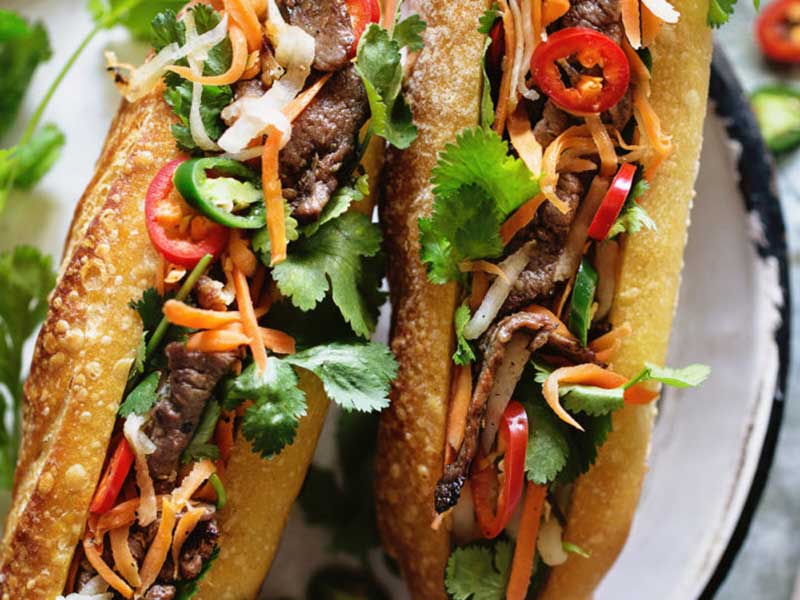The Origins of Banh Mi
Early Influences
Banh Mi traces its roots back to the period of French colonization in Vietnam during the late 19th century. The French introduced baguettes, pâté, and various types of cold cuts to the Vietnamese culinary scene. These ingredients, combined with traditional Vietnamese flavors and techniques, laid the foundation for the birth of Banh Mi.Evolution of the Sandwich
Over time, the Banh Mi underwent modifications to cater to local tastes and ingredients. Vietnamese bakers adapted the baguette recipe, making it lighter and airier, resulting in a crusty exterior and a soft, fluffy interior. The sandwich fillings also evolved, incorporating a wide array of ingredients such as grilled pork, chicken, tofu, pickled vegetables, herbs, and sauces, creating a harmonious blend of flavors.
The Cultural Significance of Banh Mi
Street Food Staple
Banh Mi quickly became a popular street food in Vietnam, known for its affordability, portability, and delicious taste. Vendors set up makeshift stalls on street corners, offering Banh Mi to hungry locals and curious travelers alike. Its accessibility made it a beloved staple of Vietnamese cuisine, and its popularity soon spread beyond the borders of Vietnam.Culinary Fusion
Banh Mi showcases the fusion of Vietnamese and French culinary traditions, reflecting the complex history and cultural exchanges between the two nations. It symbolizes the blending of ingredients, techniques, and flavors from different cultures, resulting in a culinary masterpiece that is uniquely Vietnamese.Banh Mi Goes Global
International Recognition
In recent years, Banh Mi has gained international recognition as one of the world’s most delicious sandwiches. Food enthusiasts and travelers from all corners of the globe seek out Banh Mi vendors in Vietnamese communities and trendy food markets. Its unique combination of flavors, textures, and freshness has captivated taste buds worldwide.Fusion Variations
As Banh Mi’s popularity soared, creative chefs and food enthusiasts started experimenting with new variations of the sandwich. Fusion Banh Mi emerged, incorporating elements from other cuisines such as Korean, Mexican, and American. These innovative twists on the classic sandwich add even more diversity to the Banh Mi experience.Understanding AI Technology
Conclusion
The history of Banh Mi is a testament to the power of culinary fusion and cultural exchange. From its humble origins as a result of French colonization to its global recognition, Banh Mi has become a beloved symbol of Vietnamese cuisine. Its unique blend of flavors, affordability, and portability have made it a street food favorite worldwide. Whether you enjoy a traditional Banh Mi or one of its fusion variations, this Vietnamese sandwich is sure to satisfy your taste buds and leave you craving for more.What is the History Behind the Dish Haggis?
Haggis is a traditional Scottish dish with a rich history. Dating back centuries, the history of haggis is deeply intertwined with Scottish culture and its culinary traditions. This savory pudding-like dish is made from sheep’s heart, liver, and lungs, combined with oats, onions, and various spices. Originally, haggis was cooked encased in the animal’s stomach, but modern versions use synthetic casings. Despite its unique ingredients and preparation, haggis has become an iconic Scottish delicacy, representing a connection to the country’s past and heritage.
The Origins of Banh MiEarly InfluencesEvolution of the SandwichThe Cultural Significance of Banh MiStreet Food StapleCulinary FusionBanh Mi Goes GlobalInternational RecognitionFusion VariationsConclusionWhat is the History Behind the Dish Haggis?FAQs (Frequently Asked Questions)Is Banh Mi a spicy sandwich?Can I make Banh Mi at home?Are there vegetarian or vegan options for Banh Mi?What makes Banh Mi different from other sandwiches?Where can I find the best Banh Mi?





